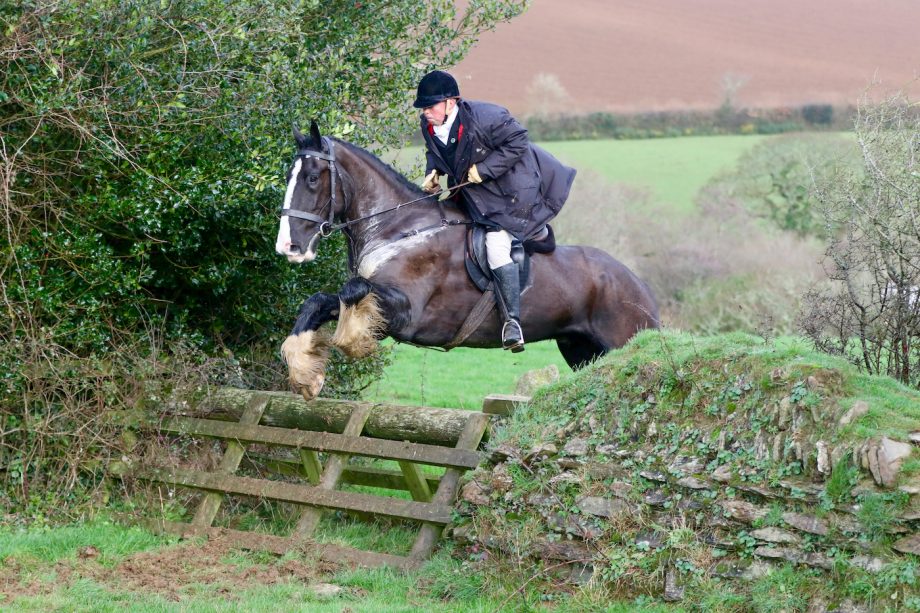Why are some hunting coats red, some yellow, some blue? Andrew Sallis MFH explains the history of hunt liveries
WHEN at a masters’ meeting some years ago, the topic of the kennel-huntsman’s frequent “visits” to see a married lady subscriber was misguidedly attributed to “scarlet fever”. My joint-master, deep into his seventies and south of a barrel of liqueur, retorted forlornly that despite trying, he had failed to have that “feverish” effect, but hadn’t given up hope.
Whether it is at school, on the parade ground, football pitch or hunting field, uniforms are worn with pride. School uniforms are considered a great leveller among peers. Hunt liveries try to raise the bar universally out of respect for the office or privilege held, the farmers and the landowners.
The histories behind individual hunt liveries tell an important narrative of British country life stretching back centuries, taking in some of the great families and events en route.
{"content":"PHA+VGhlIHJlZCBjb2F0IHN5bm9ueW1vdXMgd2l0aCBmb3hodW50aW5nIGhhcyBpdHMgcm9vdHMgaW4gdGhlIG1pbGl0YXJ5LCBhbHRob3VnaCBpdHMgZXhhY3QgcHJvdmVuYW5jZSBoYXMgYmVlbiBsb3N0LiBIb3dldmVyLCBjb3JyZWN0IHRlcm1pbm9sb2d5IGhhcyBhbHdheXMgYmVlbiBpbXBvcnRhbnQuIEFzIGEgc3R1ZGVudCBtYXN0ZXIgb2YgYmVhZ2xlcywgSSB3YXMgZmlybWx5IHJlbWluZGVkIGJ5IGFuIGVsZGVyIHRoYXQsIOKAnEhvdW5kcyBkaXZpZGUgYW5kIGJhbmFuYXMgc3BsaXQsIGh1bnRzbWVuIHdlYXIgY29hdHMgYW5kIHBvdGF0b2VzIGhhdmUgamFja2V0cy7igJ08L3A+CjxwPkh1bnRzbWVuIGluIHBpbmsgamFja2V0cyBhcmUgdGhlIHN0dWZmIG9mIERpc25leS4gQSBjb2F0IGlzIHJlZCwgb2NjYXNpb25hbGx5IHNjYXJsZXQgYnV0IG5ldmVyIHBpbmssIGFuIGVycm9uZW91cyByZWZlcmVuY2UgdG8gYSBMb25kb24gdGFpbG9yLjwvcD4KPHA+PGRpdiBjbGFzcz0iYWQtY29udGFpbmVyIGFkLWNvbnRhaW5lci0tbW9iaWxlIj48ZGl2IGlkPSJwb3N0LWlubGluZS0yIiBjbGFzcz0iaXBjLWFkdmVydCI+PC9kaXY+PC9kaXY+PHNlY3Rpb24gaWQ9ImVtYmVkX2NvZGUtMzEiIGNsYXNzPSJoaWRkZW4tbWQgaGlkZGVuLWxnIHMtY29udGFpbmVyIHN0aWNreS1hbmNob3IgaGlkZS13aWRnZXQtdGl0bGUgd2lkZ2V0X2VtYmVkX2NvZGUgcHJlbWl1bV9pbmxpbmVfMiI+PHNlY3Rpb24gY2xhc3M9InMtY29udGFpbmVyIGxpc3RpbmctLXNpbmdsZSBsaXN0aW5nLS1zaW5nbGUtc2hhcmV0aHJvdWdoIGltYWdlLWFzcGVjdC1sYW5kc2NhcGUgZGVmYXVsdCBzaGFyZXRocm91Z2gtYWQgc2hhcmV0aHJvdWdoLWFkLWhpZGRlbiI+DQogIDxkaXYgY2xhc3M9InMtY29udGFpbmVyX19pbm5lciI+DQogICAgPHVsPg0KICAgICAgPGxpIGlkPSJuYXRpdmUtY29udGVudC1tb2JpbGUiIGNsYXNzPSJsaXN0aW5nLWl0ZW0iPg0KICAgICAgPC9saT4NCiAgICA8L3VsPg0KICA8L2Rpdj4NCjwvc2VjdGlvbj48L3NlY3Rpb24+PC9wPgo8aDM+U0VFSU5HIFJFRDwvaDM+CjxwPklUIGlzIGVhc3kgdG8gdGhpbmsgb2YgaHVudGluZyBhdHRpcmUgYXMgc3R1Y2sgaW4gdGltZSwgYnV0IHRoZSByZWFsaXR5IGlzIHF1aXRlIGRpZmZlcmVudC4gU3RyYW5nZSBhcyBpdCBtYXkgc2VlbSB0byBzb21lIG91dHNpZGVycywgcG9tcG9zaXR5IGFuZCBwcmV0ZW5zaW9uIGFyZSByYXJlbHkgZmFjdG9ycywgYnV0IGZldyB0b3BpY3MgYXJlIGxlc3MgZ2xvYmFsbHkgaW1wb3J0YW50IGFuZCB5ZXQgY2FwYWJsZSBvZiByYWlzaW5nIGJvdGggYmxvb2QgcHJlc3N1cmUgYW5kIGV5ZWJyb3dzIHRoYW4gaHVudGluZyBhdHRpcmUsIHBhcnRpY3VsYXJseSBpZiBpdCBpcyBkZWVtZWQgaW5jb3JyZWN0LjwvcD4KPHA+SWYgbm90IGEgaHVudCBvZmZpY2lhbCwgdG8gd2VhciBhIHJlZCBjb2F0IHdpdGggc29tZSBwYWNrcyBpcyBkZWVtZWQgY3Jhc3MsIHdoZXJlYXMgb3RoZXIgaHVudHMgZGVsaWdodCBpbiBhIHNlYSBvZiByZWQgZGFzaGluZyBhY3Jvc3MgdGhlIGNvdW50cnkuPC9wPgo8cD5HZW50bGVtZW4gYXJlIHRyYWRpdGlvbmFsbHkgZ3JhbnRlZCB0aGUgcmlnaHQgdG8gd2VhciBhIHJlZCBjb2F0IG9uY2UgYXdhcmRlZCB0aGUgaHVudCBidXR0b24sIGFsdGhvdWdoIGRpc2NyZXRpb24gYW5kIGh1bWlsaXR5IGFsb25nIHdpdGggYSBwYXJ0aWN1bGFyIGh1bnTigJlzIGNvbnZlbnRpb25zIG1heSBkaWN0YXRlIHdoZW4gb3IgZXZlbiBpZiB0aGUgc2FydG9yaWFsIGxlYXAgaXMgbWFkZS4gQmV0dGVyIHRvIHdlYXIgdGhlIGh1bnQgYnV0dG9uIG9uIGEgd2VsbC1maXR0aW5nIGJsYWNrIGNvYXQgdGhhbiBmYWxsIGF0IHRoZSBmaXJzdCBpbiB5b3VyIGdsZWFtaW5nIG5ldyByZWQgY29hdC48L3A+CjxkaXYgY2xhc3M9ImFkLWNvbnRhaW5lciBhZC1jb250YWluZXItLW1vYmlsZSI+PGRpdiBpZD0icG9zdC1pbmxpbmUtMyIgY2xhc3M9ImlwYy1hZHZlcnQiPjwvZGl2PjwvZGl2Pgo8cD5UaGUgY29ycmVjdCBudW1iZXIgb2YgYnV0dG9ucyBpcyBhbHNvIGltcG9ydGFudCDigJMgdGhyZWUgZm9yIHN1YnNjcmliZXJzIGFuZCBtZW1iZXJzLCBmb3VyIGZvciBtYXN0ZXJzIGFuZCBmaXZlIChvciBvY2Nhc2lvbmFsbHkgc2l4KSBmb3IgaHVudCBzdGFmZiBhbmQgbWFzdGVycyBodW50aW5nIGhvdW5kcy48L3A+CjxwPkRpc3RpbmN0aXZlIGxpdmVyaWVzIGZvciBsYWRpZXMgYmVjYW1lIG1vcmUgZXN0YWJsaXNoZWQgYWZ0ZXIgV29ybGQgV2FyIElJLCB3aXRoIGNvbGxhcnMgb24gYmxhY2sgb3IgbmF2eSBjb2F0cywgYWx0aG91Z2ggbGFkeSBtYXN0ZXJzIGdlbmVyYWxseSBhdm9pZCB3ZWFyaW5nIHJlZCBjb2F0cy48L3A+CjxkaXYgY2xhc3M9ImFkLWNvbnRhaW5lciBhZC1jb250YWluZXItLW1vYmlsZSI+PGRpdiBpZD0icG9zdC1pbmxpbmUtNCIgY2xhc3M9ImlwYy1hZHZlcnQiPjwvZGl2PjwvZGl2Pgo8cD5VbHJpY2EgTXVycmF5IFNtaXRoLCBtYXN0ZXIgb2YgdGhlIFF1b3JuIGZyb20gMTk1OSB0byAxOTg1LCBkaXNsaWtlZCB3b21lbiB3ZWFyaW5nIHJlZCBjb2F0cyBhcywg4oCcdGhleSBlbmQgdXAgZWl0aGVyIGxvb2tpbmcgbGlrZSB0aGUg4oCYVGFsbHlobyBCYW5k4oCZIG9yIHdpemVuZWQsIGxpdHRsZSBtZW47IG5laXRoZXIgYWx0ZXJuYXRpdmUgYmVpbmcgcGFydGljdWxhcmx5IGRlc2lyYWJsZSBpbiB0aGUgaHVudGluZyBmaWVsZC7igJ08L3A+CjxwPlRpbWVzIGNoYW5nZSBhbmQgdGhlIDIxc3QgY2VudHVyeSBoYXMgaGVyYWxkZWQgbW9yZSBmZW1hbGUgaHVudCBzdGFmZiB3aG8gdGVuZCB0byB3ZWFyIHJlZC48L3A+CjxkaXYgY2xhc3M9ImFkLWNvbnRhaW5lciBhZC1jb250YWluZXItLW1vYmlsZSI+PGRpdiBpZD0icG9zdC1pbmxpbmUtNSIgY2xhc3M9ImlwYy1hZHZlcnQiPjwvZGl2PjwvZGl2Pgo8cD5UaGUgbW9zdCBzcGVjdGFjdWxhciBvZiBsaXZlcmllcyB3YXMgd29ybiBieSB0aGUgaHVudCBzZXJ2YW50cyBvZiB0aGUgQ2hhcmx0b24gSHVudCBDbHViLCB0aGUgb2xkZXN0IGRvY3VtZW50ZWQgcGFjayBvZiBob3VuZHMgc29sZWx5IHVzZWQgdG8gaHVudCB0aGUgZm94LCBtb3JlIHRoYW4gMzAwIHllYXJzIGFnbyBhbmQgaW1tb3J0YWxpc2VkIGluIG9pbHMgYnkgR2FpbnNib3JvdWdoLjwvcD4KPHA+SW4gdGhlaXIgYnJpZ2h0IHllbGxvdyBjb2F0cyB3aXRoIHJlZCBjdWZmcyBhbmQgY29sbGFycywgdGhlIHNlcnZhbnRz4oCZIGxpdmVyeSBvZiB0aGUgRHVrZSBvZiBSaWNobW9uZCBhbmQgTGVubm94LCB0aGV5IGxlZCB0aGUgbW91bnRlZCBmaWVsZCBkcmVzc2VkIGluIOKAnENoYXJsdG9u4oCdIGJsdWUgY29hdHMgYWNyb3NzIHRoZSBTb3V0aCBEb3ducywgZnJvbSB0aGUgZHVjYWwgZXN0YXRlIGF0IEdvb2R3b29kLiBXZXN0IFN1c3NleCwgbm90IE1lbHRvbiBNb3dicmF5LCB3YXMgaHVudGluZ+KAmXMgbWVjY2EgYW5kIHRoZSBzdWJzY3JpYmVyc+KAmSBsaXN0IHJlYWQgbGlrZSB0aGUgdXBwZXIgZWNoZWxvbnMgb2YgQnVya2XigJlzIFBlZXJhZ2UuPC9wPgo8cD5UaGUgR29vZHdvb2QgZXN0YXRlIHN0aWxsIG1haW50YWlucyBpdHMgc3VwcG9ydCBvZiBpdHMgbG9jYWwgaHVudCBhbmQgdGhlIENoYXJsdG9uIGJsdWUgbmVhdGx5IHRpZXMgaW4gd2l0aCB0aGUgTGVjb25maWVsZCBibHVlIHNwb3J0ZWQgYnkgdGhlIENoaWRkaW5nZm9sZCwgTGVjb25maWVsZCBhbmQgQ293ZHJheSBIdW50LjwvcD4KPHA+QXMgaXMgZm94aHVudGluZyBjb252ZW50aW9uLCByZWQgY29hdHMgaGFkIGJlZW4gd29ybiBmb3IgZ2VuZXJhdGlvbnMsIGJ1dCB0aGUgYmx1ZSBvZiB0aGUgTGVjb25maWVsZCBmYW1pbHkgc2VydmFudHPigJkgbGl2ZXJ5IHdhcyBhZG9wdGVkIGR1cmluZyB0aGUgbGF0dGVyIHBhcnQgb2YgUmljaGFyZCBCYXJsb3figJlzIGRpc3Rpbmd1aXNoZWQgbWFzdGVyc2hpcCBmcm9tIDE5MzYgdG8gMTk5MC48L3A+CjxkaXYgaWQ9ImF0dGFjaG1lbnRfNzQ3MTA1IiBzdHlsZT0id2lkdGg6IDI1NzBweCIgY2xhc3M9IndwLWNhcHRpb24gYWxpZ25ub25lIj48aW1nIGZldGNocHJpb3JpdHk9ImhpZ2giIGRlY29kaW5nPSJhc3luYyIgYXJpYS1kZXNjcmliZWRieT0iY2FwdGlvbi1hdHRhY2htZW50LTc0NzEwNSIgY2xhc3M9Imxhenlsb2FkIGJsdXItdXAgc2l6ZS1mdWxsIHdwLWltYWdlLTc0NzEwNSIgZGF0YS1wcm9jZXNzZWQgc3JjPSJodHRwczovL2tleWFzc2V0cy50aW1laW5jdWsubmV0L2luc3BpcmV3cC9saXZlL3dwLWNvbnRlbnQvdXBsb2Fkcy9zaXRlcy8xNC8yMDE3LzAzL25ldy1oaC1wbGFjZWhvbGRlci0yMDB4MjAwLnBuZyIgZGF0YS1zcmM9Imh0dHBzOi8va2V5YXNzZXRzLnRpbWVpbmN1ay5uZXQvaW5zcGlyZXdwL2xpdmUvd3AtY29udGVudC91cGxvYWRzL3NpdGVzLzE0LzIwMjEvMDYvSEFIMzA4Lmh0X2xpdmVyaWVzLmNoaWRkaW5nZm9sZF9odW50aW5nXzE2cG5fMjM2OTJfdGlfYXJjaGl2ZS1zY2FsZWQuanBlZyIgYWx0PSJKdWxpYW4gRWRnZSAoTWFzdGVyKSBhbmQgTXIgQSBUaG9tcHNvbiAoMXN0IFdoaXAsIGJ1dCBhY3RpbmcgYXMgSHVudHNtYW4gZHVyaW5nIHRoZSBkYXkpIHdpdGggdGhlIENoaWRkaW5nZm9sZCBIb3VuZHMgZHVyaW5nIHRoZSBNb2NrYmVnZ2FycyBtZWV0IG9mIHRoZSBDaGlkZGluZ2ZvbGQgSHVudCAgaG9zdGVkIGJ5IEhhcnJpZXQgQ2hhcmxlcyBhbmQgUmljaGFyZCBIZXh0YWxsIG5lYXIgQmlsbGluZ3NodXJzdCBpbiBXZXN0IFN1c3NleCwgVUsgb24gN3RoIERlY2VtYmVyIDIwMTYiIHdpZHRoPSIyNTYwIiBoZWlnaHQ9IjE0NDEiIGRhdGEtc2l6ZXM9ImF1dG8iIGRhdGEtc3Jjc2V0PSJodHRwczovL2tleWFzc2V0cy50aW1laW5jdWsubmV0L2luc3BpcmV3cC9saXZlL3dwLWNvbnRlbnQvdXBsb2Fkcy9zaXRlcy8xNC8yMDIxLzA2L0hBSDMwOC5odF9saXZlcmllcy5jaGlkZGluZ2ZvbGRfaHVudGluZ18xNnBuXzIzNjkyX3RpX2FyY2hpdmUtc2NhbGVkLmpwZWcgMjU2MHcsIGh0dHBzOi8va2V5YXNzZXRzLnRpbWVpbmN1ay5uZXQvaW5zcGlyZXdwL2xpdmUvd3AtY29udGVudC91cGxvYWRzL3NpdGVzLzE0LzIwMjEvMDYvSEFIMzA4Lmh0X2xpdmVyaWVzLmNoaWRkaW5nZm9sZF9odW50aW5nXzE2cG5fMjM2OTJfdGlfYXJjaGl2ZS0zMDB4MTY5LmpwZWcgMzAwdywgaHR0cHM6Ly9rZXlhc3NldHMudGltZWluY3VrLm5ldC9pbnNwaXJld3AvbGl2ZS93cC1jb250ZW50L3VwbG9hZHMvc2l0ZXMvMTQvMjAyMS8wNi9IQUgzMDguaHRfbGl2ZXJpZXMuY2hpZGRpbmdmb2xkX2h1bnRpbmdfMTZwbl8yMzY5Ml90aV9hcmNoaXZlLTYzMHgzNTUuanBlZyA2MzB3LCBodHRwczovL2tleWFzc2V0cy50aW1laW5jdWsubmV0L2luc3BpcmV3cC9saXZlL3dwLWNvbnRlbnQvdXBsb2Fkcy9zaXRlcy8xNC8yMDIxLzA2L0hBSDMwOC5odF9saXZlcmllcy5jaGlkZGluZ2ZvbGRfaHVudGluZ18xNnBuXzIzNjkyX3RpX2FyY2hpdmUtMTM1eDc2LmpwZWcgMTM1dywgaHR0cHM6Ly9rZXlhc3NldHMudGltZWluY3VrLm5ldC9pbnNwaXJld3AvbGl2ZS93cC1jb250ZW50L3VwbG9hZHMvc2l0ZXMvMTQvMjAyMS8wNi9IQUgzMDguaHRfbGl2ZXJpZXMuY2hpZGRpbmdmb2xkX2h1bnRpbmdfMTZwbl8yMzY5Ml90aV9hcmNoaXZlLTE1MzZ4ODY1LmpwZWcgMTUzNncsIGh0dHBzOi8va2V5YXNzZXRzLnRpbWVpbmN1ay5uZXQvaW5zcGlyZXdwL2xpdmUvd3AtY29udGVudC91cGxvYWRzL3NpdGVzLzE0LzIwMjEvMDYvSEFIMzA4Lmh0X2xpdmVyaWVzLmNoaWRkaW5nZm9sZF9odW50aW5nXzE2cG5fMjM2OTJfdGlfYXJjaGl2ZS0yMDQ4eDExNTMuanBlZyAyMDQ4dywgaHR0cHM6Ly9rZXlhc3NldHMudGltZWluY3VrLm5ldC9pbnNwaXJld3AvbGl2ZS93cC1jb250ZW50L3VwbG9hZHMvc2l0ZXMvMTQvMjAyMS8wNi9IQUgzMDguaHRfbGl2ZXJpZXMuY2hpZGRpbmdmb2xkX2h1bnRpbmdfMTZwbl8yMzY5Ml90aV9hcmNoaXZlLTMyMHgxODAuanBlZyAzMjB3LCBodHRwczovL2tleWFzc2V0cy50aW1laW5jdWsubmV0L2luc3BpcmV3cC9saXZlL3dwLWNvbnRlbnQvdXBsb2Fkcy9zaXRlcy8xNC8yMDIxLzA2L0hBSDMwOC5odF9saXZlcmllcy5jaGlkZGluZ2ZvbGRfaHVudGluZ18xNnBuXzIzNjkyX3RpX2FyY2hpdmUtNjIweDM0OS5qcGVnIDYyMHcsIGh0dHBzOi8va2V5YXNzZXRzLnRpbWVpbmN1ay5uZXQvaW5zcGlyZXdwL2xpdmUvd3AtY29udGVudC91cGxvYWRzL3NpdGVzLzE0LzIwMjEvMDYvSEFIMzA4Lmh0X2xpdmVyaWVzLmNoaWRkaW5nZm9sZF9odW50aW5nXzE2cG5fMjM2OTJfdGlfYXJjaGl2ZS05MjB4NTE4LmpwZWcgOTIwdywgaHR0cHM6Ly9rZXlhc3NldHMudGltZWluY3VrLm5ldC9pbnNwaXJld3AvbGl2ZS93cC1jb250ZW50L3VwbG9hZHMvc2l0ZXMvMTQvMjAyMS8wNi9IQUgzMDguaHRfbGl2ZXJpZXMuY2hpZGRpbmdmb2xkX2h1bnRpbmdfMTZwbl8yMzY5Ml90aV9hcmNoaXZlLTEyMjB4Njg3LmpwZWcgMTIyMHcsIGh0dHBzOi8va2V5YXNzZXRzLnRpbWVpbmN1ay5uZXQvaW5zcGlyZXdwL2xpdmUvd3AtY29udGVudC91cGxvYWRzL3NpdGVzLzE0LzIwMjEvMDYvSEFIMzA4Lmh0X2xpdmVyaWVzLmNoaWRkaW5nZm9sZF9odW50aW5nXzE2cG5fMjM2OTJfdGlfYXJjaGl2ZS0xNjIweDkxMi5qcGVnIDE2MjB3LCBodHRwczovL2tleWFzc2V0cy50aW1laW5jdWsubmV0L2luc3BpcmV3cC9saXZlL3dwLWNvbnRlbnQvdXBsb2Fkcy9zaXRlcy8xNC8yMDIxLzA2L0hBSDMwOC5odF9saXZlcmllcy5jaGlkZGluZ2ZvbGRfaHVudGluZ18xNnBuXzIzNjkyX3RpX2FyY2hpdmUtMTkyMHgxMDgxLmpwZWcgMTkyMHciIHNpemVzPSIobWF4LXdpZHRoOiAyNTYwcHgpIDEwMHZ3LCAyNTYwcHgiIC8+PHAgaWQ9ImNhcHRpb24tYXR0YWNobWVudC03NDcxMDUiIGNsYXNzPSJ3cC1jYXB0aW9uLXRleHQiPlRoZSBDaGlkZGluZ2ZvbGQsIExlY29uZmllbGQgYW5kIENvd2RyYXkgSHVudOKAmXMgTGVjb25maWVsZCBibHVlIGNvYXRzIHRpZSBpbiB3aXRoIHRoZSBhcmVh4oCZcyBkaXN0aW5ndWlzaGVkIGhpc3Rvcnkgb2YgdGhlIENoYXJsdG9uIGJsdWU8L3A+PC9kaXY+CjxwPlRoZSBuZWlnaGJvdXJpbmcgSGFtcHNoaXJlIEh1bnQsIGtub3duIG1vcmUgY29tbW9ubHkgYXMgdGhlIOKAnEhI4oCdIGFuZCBvbmUgb2YgRW5nbGFuZOKAmXMgb2xkZXN0IGh1bnRzLCB3YXMgZm91bmRlZCBpbiAxNzQ1LiBUaGUgb3JpZ2luYWwgbWVtYmVycyB3b3JlIGJsdWUgY29hdHMgd2l0aCBsYXJnZSBzaWx2ZXIgYnV0dG9ucyBlbmdyYXZlZCB3aXRoIOKAnEhI4oCdLjwvcD4KPHA+VG93YXJkcyB0aGUgZW5kIG9mIHRoZSAxOHRoIGNlbnR1cnksIHRoZSBodW504oCZcyBmb3J0dW5lcyB3ZXJlIG1peGVkIHdpdGggc3RhZ2hvdW5kcyBhbmQgbGF0dGVybHkgZm94aG91bmRzIG9mIHRoZSBQcmluY2Ugb2YgV2FsZXMsIGxhdGVyIEdlb3JnZSBJViwgd2hvIGdyYW50ZWQgbWVtYmVycyBvZiB0aGUgSEggcGVybWlzc2lvbiB0byB3ZWFyIHRoZSBQcmluY2Ugb2YgV2FsZXPigJkgZmVhdGhlcnMsIGVtYm9zc2VkIGludG8gdGhlIGh1bnQgYnV0dG9uLiBUaGlzIHBlcm1pc3Npb24gaGFzIGJlZW4gc291Z2h0IGFuZCBncmFudGVkIGJ5IGV2ZXJ5IHN1Y2NlZWRpbmcgUHJpbmNlIG9mIFdhbGVzLjwvcD4KPHA+TmF2eSBjb2F0cyBnYXZlIHdheSB0byByZWQgb3ZlciB0aW1lLCBidXQgbW9kZXJuIGNvbnNpZGVyYXRpb25zIHByb21wdGVkIHRoZSBodW50IHRvIGFkb3B0IGl0cyBvcmlnaW5hbCBsaXZlcnkgb25jZSBhZ2FpbiBpbiAyMDA1LjwvcD4KPHA+Sm9pbnQtbWFzdGVyIFJ1cGVydCBIYXJ2aWUgZXhwbGFpbnMsIOKAnFRoZSBodW50IHN0YWZmIHdlcmVu4oCZdCB0b28ga2VlbiB0byBkaXRjaCB0aGVpciByZWQgY29hdHMgZm9yIHRoZSBuZXcgYmx1ZSB1bmlmb3JtLCBidXQgd2UgZGlkIGdldCBhIGxvdCBsZXNzIHJvYWRzaWRlIGFidXNlLiBJdOKAmXMgaXJyYXRpb25hbCwgYnV0IHNhZGx5IHRydWUu4oCdPC9wPgo8cD5XaGVuIHRoZSBwb2xpdGljYWwgY2xpbWF0ZSBwZXJtaXR0ZWQgdGhlIGN1cnJlbnQgUHJpbmNlIG9mIFdhbGVzIHRvIGh1bnQsIGhlIHdvcmUgdGhlIHNtYXJ0IFdpbmRzb3IgbGl2ZXJ5IG9mIG5hdnkgY29hdCB3aXRoIHJlZCBjb2xsYXIgYW5kIGN1ZmZzLjwvcD4KPHA+SG91bmRzIGhhdmUgYmVlbiBrZXB0IGJ5IHRoZSBCZXJrZWxleSBmYW1pbHkgc2luY2UgdGhlIDEydGggY2VudHVyeS4gRm9yIGNlbnR1cmllcywgdGhlaXIgaHVudGluZyBlbXBpcmUgc3RyZXRjaGVkIGZyb20gQ2hhcmluZyBDcm9zcyB0byBCZXJrZWxleSBDYXN0bGUsIGVuY29tcGFzc2luZyBmaXZlLCBzb21ldGltZXMgc2l4IGtlbm5lbHMuIFRoZSBtYXN0ZXJzIGFuZCBodW50IHN0YWZmIHdlYXIgdGhlIHllbGxvdyBjb2F0cyB3aXRoIGdyZWVuIGNvbGxhcnMgb2YgdGhlIGZhbWlseeKAmXMgc2VydmFudHPigJkgb3V0ZG9vciBsaXZlcnksIGFkb3JuZWQgd2l0aCBhIHJ1bm5pbmcgZm94IG9uIHRoZSBsYXBlbC48L3A+CjxwPlRoZSBjb3VudHJ5IGFyb3VuZCBDaGVsdGVuaGFtIHdhcyBldmVudHVhbGx5IGNlZGVkIGluIHRoZSBtaWQtMTl0aCBjZW50dXJ5IHRvIGZvcm0gdGhlIENvdHN3b2xkIGFuZCBOb3J0aCBDb3Rzd29sZCwgd2hvc2UgcmVzcGVjdGl2ZSBncmVlbiBhbmQgcHJpbXJvc2UgY29sbGFycyBvbiByZWQgY29hdHMgaW5kaWNhdGUgdGhlaXIgQmVya2VsZXkgbGluZWFnZS48L3A+CjxoMz5LQUxFSURPU0NPUElDPC9oMz4KPHA+REVDSURJTkcgb24gbGl2ZXJ5IGFmdGVyIGFuIGFtYWxnYW1hdGlvbiBjYW4gYmUgYW4gZXhjdXNlIGZvciBhIGRlY2VudCBodW50IHJvdyBpZiBub3QgaGFuZGxlZCBzZW5zaXRpdmVseS4gVGhhbmtmdWxseSwgbW9zdCBhbWFsZ2FtYXRpb25zIGVyciBhd2F5IGZyb20gc2VuZGluZyB0aGVpciBodW50IHN0YWZmIG91dCBodW50aW5nIGxvb2tpbmcgbGlrZSBKb3NlcGggaW4gaGlzIHRlY2huaWNvbG91ciBkcmVhbWNvYXQuPC9wPgo8cD5UaGUgS2ltYmxld2ljaywgYSBzdWNjZXNzZnVsIGFtYWxnYW1hdGlvbiBvZiBmaXZlIG9yaWdpbmFsIGh1bnRzLCBjaG9zZSB0aGUgZGlzdGluY3RpdmUgbGl2ZXJ5IG9mIGl0cyBhbmNlc3RvciB0aGUgVmFsZSBvZiBBeWxlc2J1cnksIGl0c2VsZiBhIHN1Y2Nlc3NvciB0byB0aGUgT2xkIEJlcmtlbGV5IEh1bnQsIGZvcm1hbGx5IGZvdW5kZWQgaW4gdGhlIDE4NjBzLjwvcD4KPHA+VGhlIGp1cnkgaXMgb3V0IG9uIGl0cyBuYW1lIOKAkyB5ZWxsb3csIHRhd255IG9yIG11c3RhcmQuIFRoZWlyIGNvbG91ciBpcyBzbGlnaHRseSBkYXJrZXIgdGhhbiB0aGUgQmVya2VsZXkgeWVsbG93LCBhcG9jcnlwaGFsbHkgYXR0cmlidXRlZCB0byB0aGUgb2xkZXIsIHVzZWQgY29hdHMgbGVmdCB0byB0aGUgaHVudCBieSBpdHMgZm9yZWJlYXJzIGluIEdsb3VjZXN0ZXJzaGlyZS48L3A+CjxwPlR3byBmYW1vdXMgcGFja3Mgb2YgaG91bmRzIHdob3NlIGh1bnQgY29hdHMgYXJlIHNpbWlsYXIgeWV0IHVuY29ubmVjdGVkIG9ubHkgYWRvcHRlZCB0aGVpciB1bnVzdWFsIHNoYWRlIG9mIHJlZCwgYSBQYWR1YSByZWQgaW4gdGhlIGNhc2Ugb2YgdGhlIFB5dGNobGV5IGFuZCBzdWJ0bHkgZGlmZmVyZW50IHBsdW0gY29sb3VyIGZvciB0aGUgU291dGggYW5kIFdlc3QgV2lsdHMsIGluIHRoZSBmaXJzdCBwYXJ0IG9mIHRoZSAyMHRoIGNlbnR1cnksIHNldmVyYWwgY2VudHVyaWVzIGFmdGVyIHRoZXkgd2VyZSBpbmRpdmlkdWFsbHkgZm9ybWVkLjwvcD4KPHA+RGFuaWVsIENoZXJyaW1hbiwgd2hvIGh1bnRlZCB0aGUgUHl0Y2hsZXkgZm9yIDEwIHllYXJzLCBleHBsYWluczog4oCcTG9yZCBBbm5hbHksIGZhbWVkIGZvciBoaXMgbWFzdGVyc2hpcCBkdXJpbmcgRnJhbmsgRnJlZW1hbuKAmXMgdGVudXJlIGFzIGh1bnRzbWFuLCByZS1pbnRyb2R1Y2VkIFBhZHVhIHJlZCBjb2F0cywgbGFzdCB1c2VkIGluIHRoZSAxOHRoIGNlbnR1cnkgZnJvbSBhIGJvbHQgb2YgY2xvdGggZnJvbSBMb3d0aGVyIENhc3RsZSwgd2hvc2UgZmFtaWx5IGhhZCBhIGxvbmcgYXNzb2NpYXRpb24gd2l0aCB0aGUgUHl0Y2hsZXkuIFRoZSB3aGl0ZSBjb2xsYXJzIGhhZCBhbHdheXMgYmVlbiBwYXJ0IG9mIHRoZSBsaXZlcnksIGRlc2lnbmVkIHRvIHByb3RlY3QgY29hdHMgZnJvbSBhIHBvd2RlcmVkIHdpZy7igJ08L3A+CjxwPlRoZSBTb3V0aCBhbmQgV2VzdCBXaWx0cywgcHJvYmFibHkgdGhlIG9sZGVzdCBwYWNrIG9mIGZveGhvdW5kcyBzdGlsbCBpbiBleGlzdGVuY2UsIHRvb2sgaXRzIHNoYWRlIG9mIHJlZCBmcm9tIHRoZSBvdXRkb29yIHNlcnZhbnRzIGxpdmVyeSBvZiBMb3JkIEFydW5kZWxsIG9mIFdhcmRvdXIgQ2FzdGxlIHdobyBmb3VuZGVkIHRoZSBodW50IGluIDE2OTAuIER1cmluZyBoaXMgcmV2b2x1dGlvbmFyeSBtYXN0ZXJzaGlwIGZyb20gMTkyNSB0byAxOTM0LCBJa2V5IEJlbGwgYXNrZWQgTG9yZCBUYWxib3QsIHRoZSBjbG9zZXN0IGRlc2NlbmRlbnQgdG8gdGhlIEFydW5kZWxscywgZm9yIGhpcyBjb25zZW50IHRvIGFkb3B0IHRoZSBmYW1pbHkgbGl2ZXJ5LjwvcD4KPHA+VGhlIGZhbW91cyBncmVlbiBCZWF1Zm9ydCBjb21lcyBmcm9tIHRoZSBmYW1pbHkgb3V0ZG9vciBzZXJ2YW50c+KAmSBsaXZlcnkgd2hpY2ggd2FzIHRoZW4gYWRvcHRlZCBieSB0aGVpciBvZmZzcHJpbmcsIHRoZSBIZXl0aHJvcCwgaW4gMTgzNS4gVW5pcXVlbHkgaW4gaHVudGluZywgbGFkaWVzIGFuZCBnZW50bGVtZW4gd2hvIGFyZSBhd2FyZGVkIHRoZSBCZWF1Zm9ydCBodW50IGJ1dHRvbiBhcmUgZW50aXRsZWQgdG8gd2VhciB0aGUgc3RyaWtpbmcg4oCcYmx1ZSBhbmQgYnVmZizigJ0gd2hpbGUgZmFybWVycyBwcm91ZGx5IHdlYXIgdGhlIGh1bnQgYnV0dG9uIG9uIHRoZWlyIGJsYWNrIGNvYXQuPC9wPgo8ZGl2IGlkPSJhdHRhY2htZW50Xzc0NzEwNCIgc3R5bGU9IndpZHRoOiAyNTcwcHgiIGNsYXNzPSJ3cC1jYXB0aW9uIGFsaWdubm9uZSI+PGltZyBkZWNvZGluZz0iYXN5bmMiIGFyaWEtZGVzY3JpYmVkYnk9ImNhcHRpb24tYXR0YWNobWVudC03NDcxMDQiIGNsYXNzPSJsYXp5bG9hZCBibHVyLXVwIHNpemUtZnVsbCB3cC1pbWFnZS03NDcxMDQiIGRhdGEtcHJvY2Vzc2VkIHNyYz0iaHR0cHM6Ly9rZXlhc3NldHMudGltZWluY3VrLm5ldC9pbnNwaXJld3AvbGl2ZS93cC1jb250ZW50L3VwbG9hZHMvc2l0ZXMvMTQvMjAxNy8wMy9uZXctaGgtcGxhY2Vob2xkZXItMjAweDIwMC5wbmciIGRhdGEtc3JjPSJodHRwczovL2tleWFzc2V0cy50aW1laW5jdWsubmV0L2luc3BpcmV3cC9saXZlL3dwLWNvbnRlbnQvdXBsb2Fkcy9zaXRlcy8xNC8yMDIxLzA2L0hBSDMwOC5odF9saXZlcmllcy5iZWFnbGVzaG9uaXRvbl8wMjZfdGlfYXJjaGl2ZS1zY2FsZWQuanBnIiBhbHQ9ImJlYWdsZSByaW5nIiB3aWR0aD0iMjU2MCIgaGVpZ2h0PSIxNDQwIiBkYXRhLXNpemVzPSJhdXRvIiBkYXRhLXNyY3NldD0iaHR0cHM6Ly9rZXlhc3NldHMudGltZWluY3VrLm5ldC9pbnNwaXJld3AvbGl2ZS93cC1jb250ZW50L3VwbG9hZHMvc2l0ZXMvMTQvMjAyMS8wNi9IQUgzMDguaHRfbGl2ZXJpZXMuYmVhZ2xlc2hvbml0b25fMDI2X3RpX2FyY2hpdmUtc2NhbGVkLmpwZyAyNTYwdywgaHR0cHM6Ly9rZXlhc3NldHMudGltZWluY3VrLm5ldC9pbnNwaXJld3AvbGl2ZS93cC1jb250ZW50L3VwbG9hZHMvc2l0ZXMvMTQvMjAyMS8wNi9IQUgzMDguaHRfbGl2ZXJpZXMuYmVhZ2xlc2hvbml0b25fMDI2X3RpX2FyY2hpdmUtMzAweDE2OS5qcGcgMzAwdywgaHR0cHM6Ly9rZXlhc3NldHMudGltZWluY3VrLm5ldC9pbnNwaXJld3AvbGl2ZS93cC1jb250ZW50L3VwbG9hZHMvc2l0ZXMvMTQvMjAyMS8wNi9IQUgzMDguaHRfbGl2ZXJpZXMuYmVhZ2xlc2hvbml0b25fMDI2X3RpX2FyY2hpdmUtNjMweDM1NC5qcGcgNjMwdywgaHR0cHM6Ly9rZXlhc3NldHMudGltZWluY3VrLm5ldC9pbnNwaXJld3AvbGl2ZS93cC1jb250ZW50L3VwbG9hZHMvc2l0ZXMvMTQvMjAyMS8wNi9IQUgzMDguaHRfbGl2ZXJpZXMuYmVhZ2xlc2hvbml0b25fMDI2X3RpX2FyY2hpdmUtMTM1eDc2LmpwZyAxMzV3LCBodHRwczovL2tleWFzc2V0cy50aW1laW5jdWsubmV0L2luc3BpcmV3cC9saXZlL3dwLWNvbnRlbnQvdXBsb2Fkcy9zaXRlcy8xNC8yMDIxLzA2L0hBSDMwOC5odF9saXZlcmllcy5iZWFnbGVzaG9uaXRvbl8wMjZfdGlfYXJjaGl2ZS0xNTM2eDg2NC5qcGcgMTUzNncsIGh0dHBzOi8va2V5YXNzZXRzLnRpbWVpbmN1ay5uZXQvaW5zcGlyZXdwL2xpdmUvd3AtY29udGVudC91cGxvYWRzL3NpdGVzLzE0LzIwMjEvMDYvSEFIMzA4Lmh0X2xpdmVyaWVzLmJlYWdsZXNob25pdG9uXzAyNl90aV9hcmNoaXZlLTIwNDh4MTE1Mi5qcGcgMjA0OHcsIGh0dHBzOi8va2V5YXNzZXRzLnRpbWVpbmN1ay5uZXQvaW5zcGlyZXdwL2xpdmUvd3AtY29udGVudC91cGxvYWRzL3NpdGVzLzE0LzIwMjEvMDYvSEFIMzA4Lmh0X2xpdmVyaWVzLmJlYWdsZXNob25pdG9uXzAyNl90aV9hcmNoaXZlLTMyMHgxODAuanBnIDMyMHcsIGh0dHBzOi8va2V5YXNzZXRzLnRpbWVpbmN1ay5uZXQvaW5zcGlyZXdwL2xpdmUvd3AtY29udGVudC91cGxvYWRzL3NpdGVzLzE0LzIwMjEvMDYvSEFIMzA4Lmh0X2xpdmVyaWVzLmJlYWdsZXNob25pdG9uXzAyNl90aV9hcmNoaXZlLTYyMHgzNDkuanBnIDYyMHcsIGh0dHBzOi8va2V5YXNzZXRzLnRpbWVpbmN1ay5uZXQvaW5zcGlyZXdwL2xpdmUvd3AtY29udGVudC91cGxvYWRzL3NpdGVzLzE0LzIwMjEvMDYvSEFIMzA4Lmh0X2xpdmVyaWVzLmJlYWdsZXNob25pdG9uXzAyNl90aV9hcmNoaXZlLTkyMHg1MTguanBnIDkyMHcsIGh0dHBzOi8va2V5YXNzZXRzLnRpbWVpbmN1ay5uZXQvaW5zcGlyZXdwL2xpdmUvd3AtY29udGVudC91cGxvYWRzL3NpdGVzLzE0LzIwMjEvMDYvSEFIMzA4Lmh0X2xpdmVyaWVzLmJlYWdsZXNob25pdG9uXzAyNl90aV9hcmNoaXZlLTEyMjB4Njg2LmpwZyAxMjIwdywgaHR0cHM6Ly9rZXlhc3NldHMudGltZWluY3VrLm5ldC9pbnNwaXJld3AvbGl2ZS93cC1jb250ZW50L3VwbG9hZHMvc2l0ZXMvMTQvMjAyMS8wNi9IQUgzMDguaHRfbGl2ZXJpZXMuYmVhZ2xlc2hvbml0b25fMDI2X3RpX2FyY2hpdmUtMTYyMHg5MTIuanBnIDE2MjB3LCBodHRwczovL2tleWFzc2V0cy50aW1laW5jdWsubmV0L2luc3BpcmV3cC9saXZlL3dwLWNvbnRlbnQvdXBsb2Fkcy9zaXRlcy8xNC8yMDIxLzA2L0hBSDMwOC5odF9saXZlcmllcy5iZWFnbGVzaG9uaXRvbl8wMjZfdGlfYXJjaGl2ZS0xOTIweDEwODAuanBnIDE5MjB3IiBzaXplcz0iKG1heC13aWR0aDogMjU2MHB4KSAxMDB2dywgMjU2MHB4IiAvPjxwIGlkPSJjYXB0aW9uLWF0dGFjaG1lbnQtNzQ3MTA0IiBjbGFzcz0id3AtY2FwdGlvbi10ZXh0Ij5Nb3N0IGJlYWdsZSBwYWNrcyBzcG9ydCBncmVlbiBjb2F0cy48L3A+PC9kaXY+CjxoMz5UUkFESVRJT04gQU5EIEhFUklUQUdFPC9oMz4KPHA+QSBHUkVBVCBicmVlZGVyIG9mIHJhY2Vob3JzZXMsIGhvdW5kcyBhbmQgaGlnaGxhbmQgY2F0dGxlLCBNaWNoYWVsIFBvbGFuZCwgZm9ybWVyIG1hc3RlciBvZiB0aGUgSHVyc2xleSBhbmQgdGhlIElzbGUgb2YgV2lnaHQsIGhhcyBhbHdheXMgc291Z2h0IHRvIGJlIGFoZWFkIG9mIHRoZSBjdXJ2ZS4gSW4gYSBzaWduaWZpY2FudCBwb2xlbWljIHdyaXR0ZW4gdGhyZWUgZGVjYWRlcyBhZ28sIGhlIGFkdm9jYXRlZCB0aGUgZGl0Y2hpbmcgb2YgcmVkIGNvYXRzIGluIGZhdm91ciBvZiBtb3JlIG1vZGVzdCBhdHRpcmUsIGluIHRoZSBpbnRlcmVzdCBvZiBwdWJsaWMgcmVsYXRpb25zLjwvcD4KPHA+SW50ZXJlc3RpbmdseSwgbW9zdCBvZiBoaXMgcGlvbmVlcmluZyBpZGVhcyBoYXZlIGNvbWUgdG8gcGFzcyBpbiB0aGUgZnVsbG5lc3Mgb2YgdGltZTsgZm9yIGhpbSwgcGVyY2VwdGlvbiB3YXMga2V5LjwvcD4KPHA+RGVtYW5kcyBvZiBwb3N0LWJhbiB0cmFpbC1odW50aW5nIHNhdyBtYW55IGh1bnRzIGFsdGVyIHRoZWlyIHRyYWRpdGlvbmFsIGxpdmVyaWVzLiBUaGUgZ3JvdW5kIHNob29rIHdpdGggYWxsIHRob3NlIGxvbmctZ29uZSBtYXN0ZXJzIGFuZCBodW50c21lbiB0dXJuaW5nIGluIHRoZWlyIGdyYXZlcywgYnV0IGdlbnVpbmUgZmVhcnMgYWJvdW5kZWQgYXMgaHVudHMgZW50ZXJlZCB0aGVpciBCcmF2ZSBOZXcgV29ybGQuPC9wPgo8cD5BdCBmaXJzdCwgdGhlIGh1bnQgc3RhZmYsIG1hc3RlcnMgYW5kIG1vdW50ZWQgZmllbGQgYXQgdGhlIEJpY2VzdGVyIHdpdGggV2hhZGRvbiBDaGFzZSB3b3JlIOKAnG11ZnRp4oCdIGNvdW50cnkgY29hdHMgYmVmb3JlIHNldHRsaW5nIG9uIGNvYXRzIG1hZGUgZnJvbSBtZWxhbmdlIGdyZWVuIGNhdmFscnkgdHdpbGwuPC9wPgo8cD5UaGUgV3lubnN0YXkgaGF2ZSB3b3JuIGEgc3BlY2lhbGx5IGNvbW1pc3Npb25lZCB0d2VlZCBzaW5jZSB0aGUgZWFybHkgcG9zdC1iYW4gZGF5cy4gTG9yZCBEYXJlc2J1cnksIGpvaW50LW1hc3RlciBzaW5jZSAxOTkxIGFuZCBmb3JtZXIgY2hhaXJtYW4gb2YgdGhlIE1hc3RlcnMgb2YgRm94aG91bmRzIEFzc29jaWF0aW9uIChNRkhBKSwgZmVsdCB0aGF0IHJlZCBjb2F0cyBoYWQg4oCcYW4gZWxpdGlzdCBjb25ub3RhdGlvbiB0aGF0IGluZmxhbWVkIHRoZSBhbnRpLWh1bnQgbG9iYnnigJ0uPC9wPgo8cD5XaGV0aGVyIGl0IHdhcyB0aGUgaW1wbGllZCBsaW5rcyB0byB0aGUgbWlsaXRhcnkgb3IgYSBwZXJjZWl2ZWQgaGllcmFyY2h5LCBldmVuIHJpZGljdWxvdXMgY2xhaW1zIGFib3V0IGJlaW5nIOKAnGJsb29kIHJlZOKAnSwgbWFueSBtYXN0ZXJzIGJlbGlldmVkIHRoZSBvcHBvc2l0aW9uIGxpdGVyYWxseSDigJxzYXcgcmVk4oCdIGF0IHRoZSBzaWdodCBvZiBodW50IHVuaWZvcm1zLjwvcD4KPHA+T3BpbmlvbnMgYW5kIGV4cGVyaWVuY2VzIGRpZmZlciwgYW5kIHdoaWxlIHRoZSBNRkhBIGNlcnRhaW5seSBoYXMgYXV0aG9yaXR5IGluIGNlcnRhaW4gcmVtaXRzIG92ZXIgbWVtYmVyIGh1bnRzIGFuZCBtYXN0ZXJzLCBlYWNoIGh1bnQgaXMgYXV0b25vbW91cy4gQ2VydGFpbiBpbXBvcnRhbnQgbWF0dGVycywgZ292ZXJuZWQgYnkgcnVsZXMgYW5kIHByaW5jaXBsZXMsIHVuaXRlIGFsbCBodW50cywgYnV0IHRoZXJlIGlzIG5vdCBhIOKAnG9uZSBjYXAgZml0cyBhbGzigJ0gZGlrdGF0IG9uIG1hbnkgc3ViamVjdHMuIFdoYXQgd29ya3MgZm9yIGEgbGFyZ2UgU2hpcmVzIGVzdGFibGlzaG1lbnQgbWF5IG5vdCBmb3IgYSBmYXJtZXJz4oCZIHBhY2sgaW4gdGhlIFdlbHNoIG1vdW50YWluczogc3VjaCBpcyB0aGUgZWNsZWN0aWMgZ2xvcnkgb2YgaHVudGluZy48L3A+CjxkaXYgY2xhc3M9ImluamVjdGlvbiI+PC9kaXY+CjxwPkZvciBlYWNoIGFudGkgd2hvIHNlZXMgcmVkLCBhbm90aGVyIHN1cHBvcnRlciBzbWlsZXMuIFRyYWRpdGlvbiBhbmQgaGVyaXRhZ2UgYXJlbuKAmXQgc3VmZmljaWVudCBieSB0aGVtc2VsdmVzLCBidXQgdGhlIHNpZ2h0IG9mIGhvdW5kcyBhbmQgcmVkIGNvYXRzIGluIG91ciBnbG9yaW91cyBsYW5kc2NhcGUgc3RpbGwgZ2xhZGRlbnMgbWFueSBoZWFydHMsIG1ha2luZyB0aGVtIHNraXAgYSBiZWF0LCBub3QgbmVjZXNzYXJpbHkgZm9yIGEg4oCcZmV2ZXLigJ0gYnV0IHRoZSB0aHJpbGwgb2YgdGhlIGNoYXNlLjwvcD4KPHA+Cg=="}
This feature is also available to read in Horse & Hound magazine, on sale Thursday 3 June 2021
You may also be interested in…
“His whole persona has changed; he’s walking more upright, has more confidence; it’s changed him. And that’s horses”
Credit: Lisa Wood Photography
“You see people looking and thinking ‘Really?’ but when they see him go, they understand”





